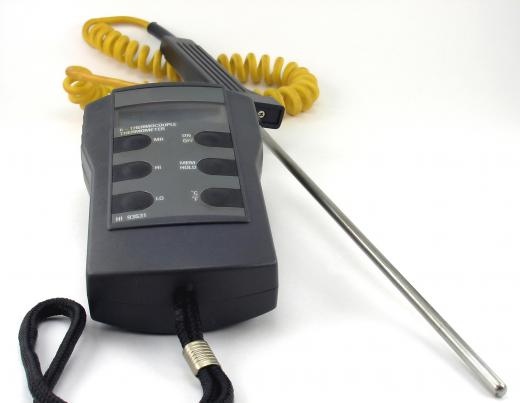Air temperature sensors comprise a variety of devices often designed to measure the ambient or surrounding atmospheric temperature. They can also be used in common industrial settings as well, such as in fuel-injected engines in automobiles to calculate air density so that the car's on-board computer can adjust fuel flow, lowering it as air density decreases to prevent loss of power. Some of the most common types of temperature sensors overall are thermocouples, resistive temperature devices (RTDs), infrared sensors, thermometers, and silicon diodes.
Thermocouples operate by the contact of two different types of metals that expand and contract at different rates depending on the temperature. They are often used as thermostats, which are temperature sensitive switches, but also can be employed as air temperature sensors due to their ability to measure across a wide temperature range, from 32° Fahrenheit (0° Celsius) up to 2,102° Fahrenheit (1,150° Celsius) or more. Thermocouple air temperature sensors are used in high-temperature environments like kilns, but are not very good at measuring minute environmental changes of fractions of a degree.

Resistive temperature devices and thermistors measure the increase or decrease in electrical resistance of matter as temperature rises. RTDs are more accurate across small temperature changes than thermocouples, but can not measure temperatures as high or low as thermocouples can. They also tend to be more long-lasting and stable than thermocouples, though their readings can be erroneous due to design and environmental conditions. Since they are not affected by surrounding electrical noise, RTDs are often used as air temperature sensors in industrial environments where powerful motors or high voltage current is present.

Infrared temperature sensors are indirect measurement devices, requiring no physical contact with the material being measured, as they are measuring the thermal radiation it produces often referred to as black body radiation. They are therefore useful in extreme environments where other sensors would fail, such as in furnaces where temperatures can exceed 5,000° Fahrenheit (2,760° Celsius) and industrial processes where heating and cooling is rapidly taking place. Silicon diode sensors operate at the opposite extreme to that of infrared sensors, and are useful at measuring extreme cold. Though they have applications as air temperature sensors in high school science experiments, they are more often used to measure cryogenic gasses in liquid form, such as liquid nitrogen, oxygen, hydrogen, and helium.
Thermometers, thermistors, and RTDs are the most commonly employed types of air temperature sensors, and are often used to measure liquid and solid temperatures as well. Typical thermometers work by measuring the expansion and contraction of either liquid mercury or an organic, red liquid in a sealed tube, as outside air temperature changes. Automotive air temperature sensors are typically thermistors. Whether they are measuring exhaust gasses, intake air flow, or engine coolant, they all operate on the same principle that as the temperature of the surrounding medium heats up, resistance in the sensor builds and the voltage signal it outputs to computer controls is reduced.
